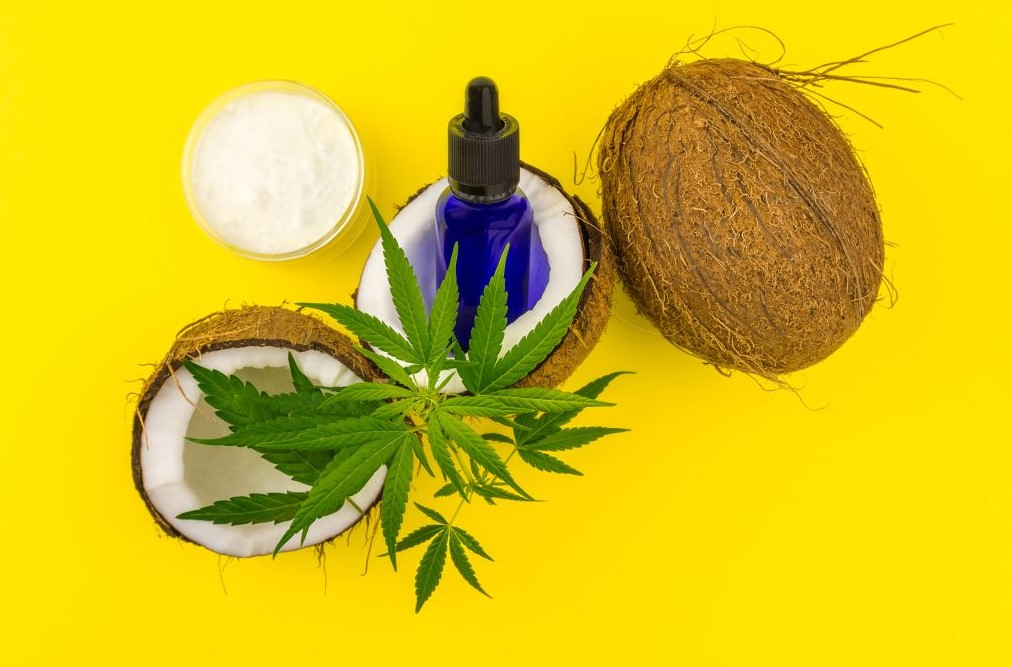Non classé
Infuse Anything With Cannabis Coconut Oil Recipe
Cannabis coconut oil is an excellent substitute for cannabutter, the more well-known edible baker’s delight. Cannabis-infused coconut oil is not only vegan and non-dairy, but it’s also a fantastic vehicle for one of this author’s favorite chemicals, THC.
Edibles are a wonderful approach to treat a wide range of illnesses. To begin, edibles’ effects endure longer than those of cigarettes or vaporizers. On average, smoking or vaporizing has an effect duration of 20 minutes. Comestibles have several advantages over cigarettes and vapes, including the fact that smaller dosages are more effective, so your
What exactly is coconut oil and why is it so common among home edible chefs everywhere?
Coconut oil is high in saturated fat. Because of this, the wonderful THC and CBD chemicals have a lot of fatty acids to stick to as they are infused. Fat attracts THC. As a result, eating edible cannabis in a fat meal or dish results in the most powerful effects (this may be why cannabutter or cannaoil brownies are so appealing). Consider this when preparing your

What Can You Do With Cannabis-Infused Coconut Oil?
Every edible chef should have a jar of cannabis-infused coconut oil on hand. It’s extremely shelf stable, and more significantly, versatile. It may be used in nearly any dish instead of butter or other vegetable oils. A spoonful of cannabis coconut oil may be used in your coffee or tea (recommendation: skip the caffeine if you’re prone to anxiety). A spoonful of coconut oil from the jar is an alternative at breakfast (or prepare some protein or vegetables in it). You can just eat coconut oil straight from the spoon without doing any cooking, mixing
Cannabis coconut oil can be used externally as a ointment, massage oil, or lubricant. Another advantage is that if stored correctly, coconut oil is very shelf stable.
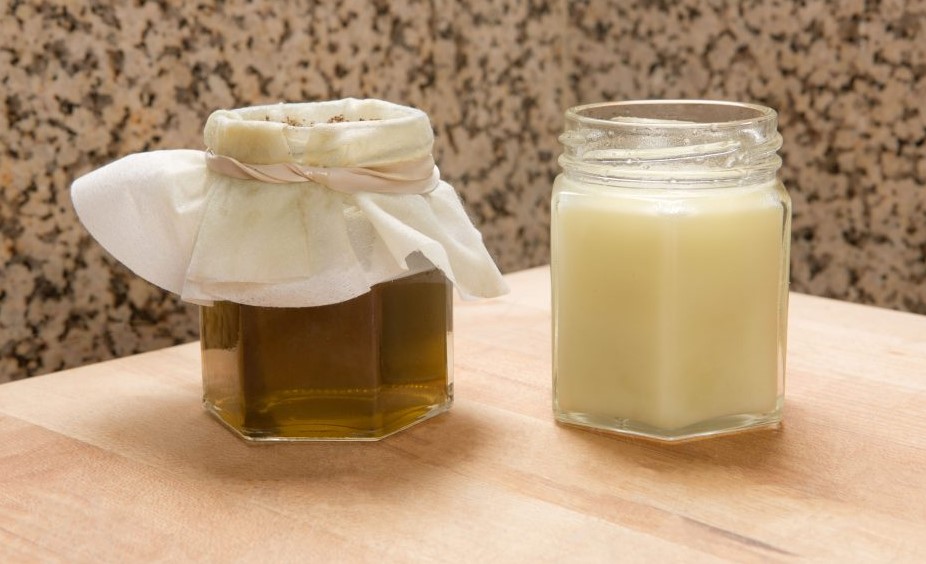
Calculating the Right Doses
You may be wondering how to calculate dosage if you’re not familiar with the procedure for making edibles. You’ll have a more educated guess than an exact dosage without a testing device or a laboratory, because you won’t be as precise. Remember that your initial few taste tests should be cautious so that you don’t overdose yourself.
To figure out how much edibles or infusions you’ll need, first determine the THC concentration of the flower. This information is typically available at the dispensary. If the plant was cultivated in your own garden, you might be able to obtain an estimate for the souche or simply go with a guess of 15%.
Let’s suppose the flower we’re using has 15% THC and is designed for this example. A gram contains 1000 mg, so we need to know how many grams are in a kilogram.
If the cannabis flower has a THC concentration of 15 percent, each gram can contain up to 150 mg of THC. On average, you won’t be able to extract all of those milligrams. You may anticipate 100 mg of THC on the high side. If you want stronger edibles, keep in mind that you’ll only absorb about 30% (or around 50 mg per gram of flower) and so double-check your dosages. You may always add more coconut oil if necessary to bring down the potency of your infusion.
The following step to consider is the ultimate dose per edible. Is it 10 mg or 50? If you’re a beginner, start with 10 and work your way up from there. You’ll also need to figure out how many edibles you’ll make: maybe a dozen cookies?
The quantity of THC in a given batch of cannabis edibles may be calculated by dividing the dose by the total number of completed medicated snacks. Let’s say we’re making 9 brownies, each with 10 milligrams of THC. We know our flower has a concentration of 15 percent THC. Maybe two if you believe people absorb at different rates
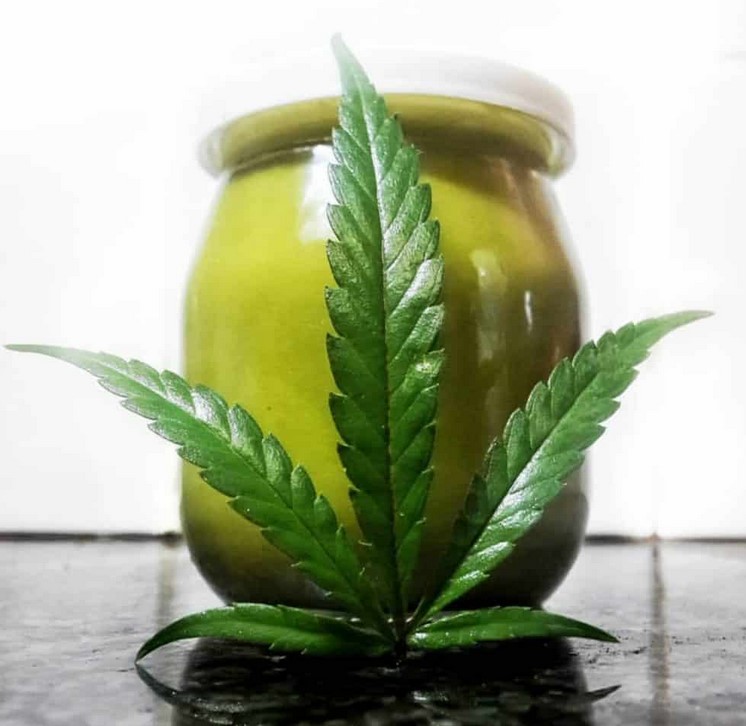
Is Lecithin Necessary to Use?
Lecithin is an excellent supplement for cannabis tinctures. Lecithin has been observed in informal research to enhance the absorption of THC and other cannabinoids in the body. Is it required? No, not in the least.
Adding oils and fats, such as gummies or other water-rich recipes, to water-based sweets may help to incorporate the oil or fat into the food. You’ll be enveloped in lecithin if you’re preparing an omelet.
Lecithin offers several benefits for baked goods, including the ability to keep your cookies or cakes from drying out. Infused butter and oil might make your final product a little dry. However, by combining twice as strong infused cannaoil with an equal amount of normal butter or coconut oil in the recipe, you may prevent this issue.
Choose the Right Oil
You could be wondering if vegetable oil is suitable for making cannabis oil. Yes, technically, but there’s a catch. Coconut oil and/or butter are frequently suggested by professional home edible chefs and bakers for a reason: they’re high in saturated fats.
THC and CBD are lipophiles, like fatty acids. They’re lipophile chemicals. These compounds are fat soluble. To obtain the best absorption and effectiveness in your edibles, use the fattiest fats and oils possible.
Coconut oil has a higher saturated fat concentration than olive oil, with coconut oil being around 60% saturated. Cannabis butter prepared using olive oil has a THC absorption rate of 60% to 80% lower than coconut oil.
Why Decarboxylation Is Important
Decarboxylation, often called decarbing, is one of the most crucial steps in producing cannabis oil. Decarboxylation is the process of changing THC or CBD in your flower from inactive to active so that it may be mixed into coconut oil. The cannabinoids present in the flower naturally cannot be broken down in your body with the same efficiency as other plant-based cannabinoids such as hemp and marijuana.
Cannabis is smoked by igniting its cannabinoids with a flame. You’ll need a baking sheet and an easy technique in your oven to decarb flower for edibles. This step should not be skipped because it is the only way to get the most out of your cannabis infusions.
Cannabis Infusion Ratio
It’s difficult for an inexperienced edible maker to know how much cannabis to use in each cup of oil. A reasonable rule of thumb is a quarter to half ounce of plant material per 1 cup of oil. You may certainly utilize more; still, it is a safe amount. You don’t want to put too much flower in there so you won’t be able to get as much out, and you don’t want to put too little because eating the whole pie may be required to obtain your dosages correctly.
Best Straining Method
The easiest way to strain your cannabis coconut oil in a crock pot is with a mesh strainer, cheesecloth, or a coffee filter. You’ll need a fine weave cheesecloth that is tight and smooth enough to allow the oil to drain, yet not so coarse that it gets caught in the strainer.
List of Supplies Needed to Make Cannabis Coconut Oil
To make coconut cannabis oil, you’ll need the following equipment and materials:
- 1 cup of coconut oil
- 7-14 grams of cannabis flower
- Baking sheet
- Tinfoil/Aluminum foil
- Mesh strainer
- Mason jar
- Scale
- Cheesecloth
- Medium saucepan or crock pot/slow cooker
How to Make Cannabis-Infused Coconut Oil
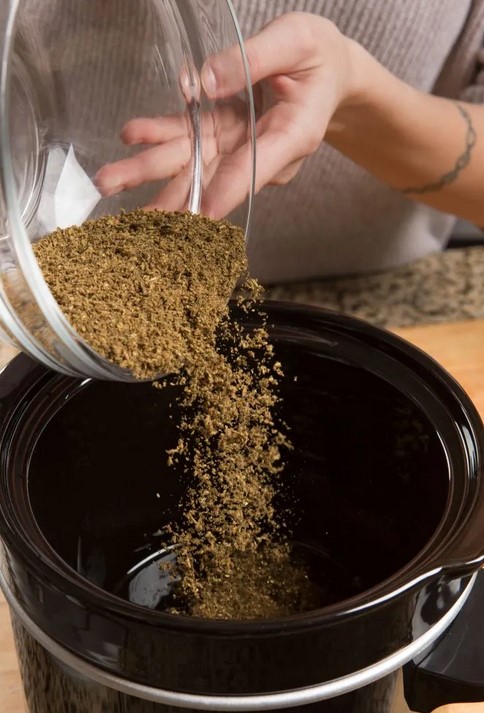
Step 1: Decarboxylate your cannabis
To decarboxylate cannabis flower, first measure it and then roughly break it apart and distribute it equally over a baking sheet. To guarantee uniform decarboxylation, the flower should be broken into equal-sized pieces. You may use a grinder to reduce the flower into smaller fragments. Cannabis flower should be baked at 240°F for 45 minutes in an oven that has been preheated. To prevent the terpenes from evaporating while allowing the plant to come to room temperature uncovered, cover the baking sheet with aluminum foil.
Step 2: Combine flower and coconut oil
Make a mason jar of your flower and coconut oil by filling it half-way with water, then adding the flower and coconut oil. Stir gently as you go in order to maintain the integrity of the contents. To allow steam to escape while keeping outside water out, tightly secure the lid on the mASON jar but not so firmly that it will fully seal during the infusion process.
Step 3: Give the jar a hot bath
Place the mason jar in a crock pot with water that has been cooled. Check the water level and make sure it’s enough to cover the top of the jar or jars (if you’re making many batches or dividing one batch among many smaller jars). If desired, place a towel in the crockpot to protect the jars from colliding.
Step 4: Let it simmer
Set the crock pot to low and cook for at least 2 hours or up to 6 hours. Every now and then, move the jars around or shake them.
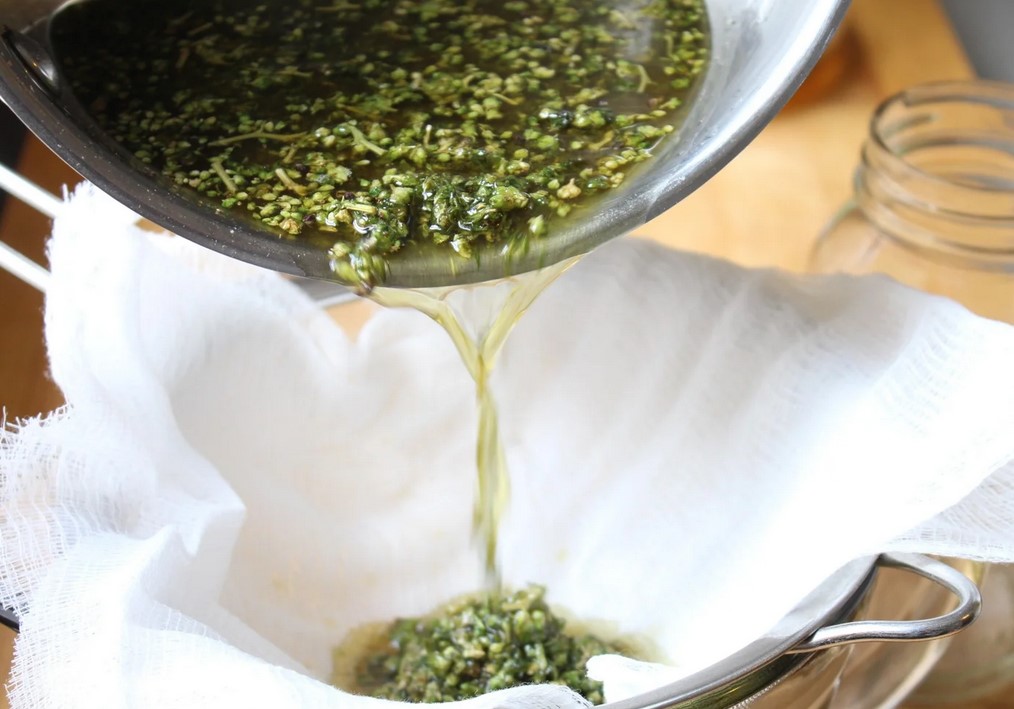
Step 5: Strain the flower out
You’ll need to get rid of the plant matter from your cannabis after the coconut oil has been infused and the jar(s) has had time to cool. Pour the oil through a cheesecloth-lined mesh strainer into a new, clean storage container or jar lined with another piece of cloth. Allow the oil to drain completely. You may gently squeeze the cheese cloth or press down on the raffinate to release additional oil; doing so, however, might make your cannabis coconut oil more green in color. Once you’ve finished draining it, seal up this container and store it correctly.
Best Way to Store Your Cannabis Coconut Oil
Another advantage of cannabis-infused coconut oil is that it has a long shelf life. If properly stored at room temperature, cannabis-infuned coconut oil has a two- to three-month shelf life.
To store coconut cannabis oil, you’ll need a clean, dry, airtight container or jar. It’s also possible that you’ll want to keep it in the refrigerator or a dark cool environment (such as a pantry or cabinet). Keeping your infusion in an amber-colored or black container can help prevent it from deteriorating by keeping it out of light.
Coconut oil may appear to be a difficult process, but with a little research and effort, you’ll be able to figure out the best dosage, approach, and recipes for your lifestyle. Many home chefs keep cannabis-infused coconut oil on hand for a purpose; take this information and apply it to see why. Also, don’t forget to leave a comment below so that others don’t get confused as to how you used your own cannabis coconut oil.


